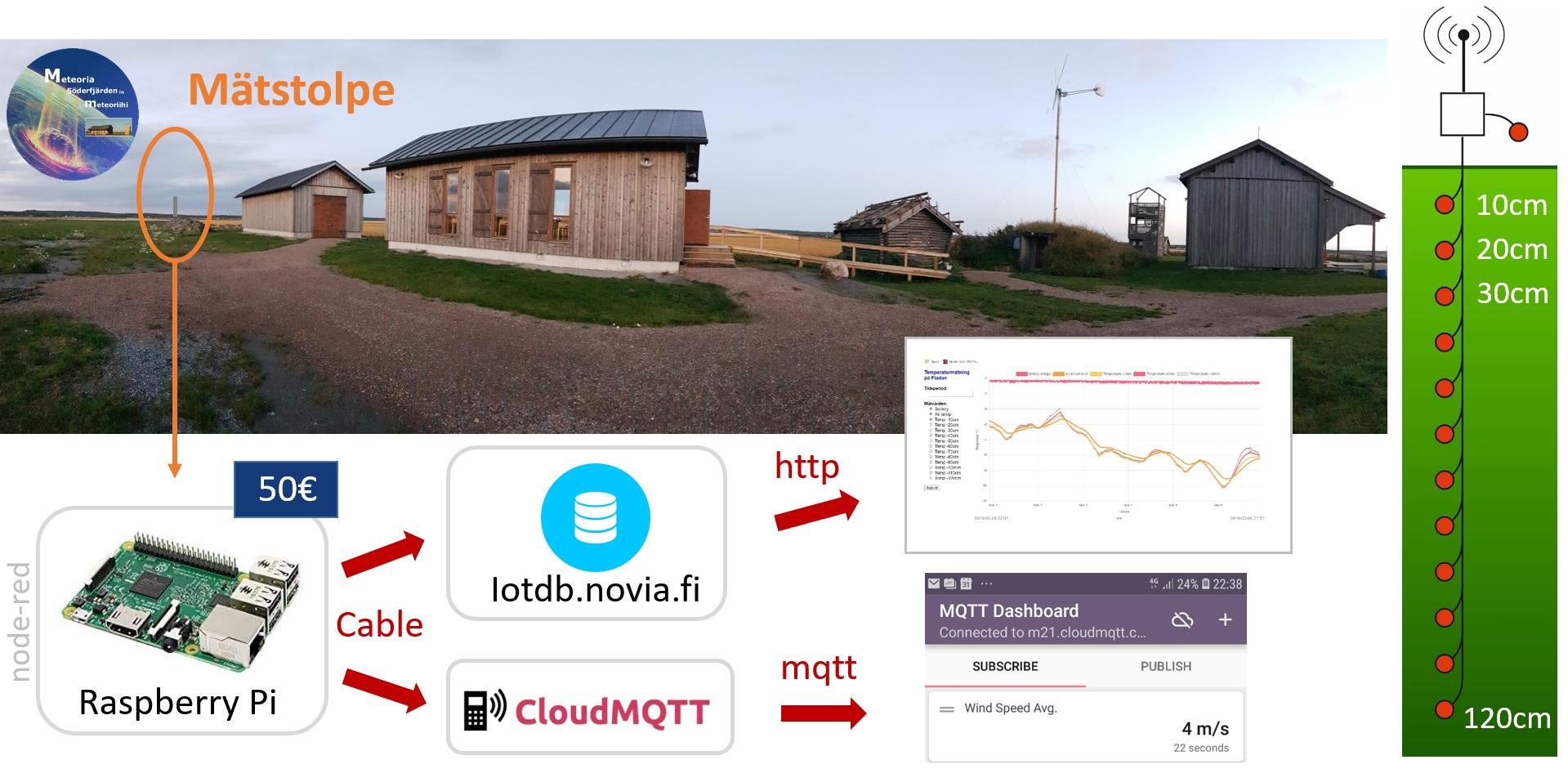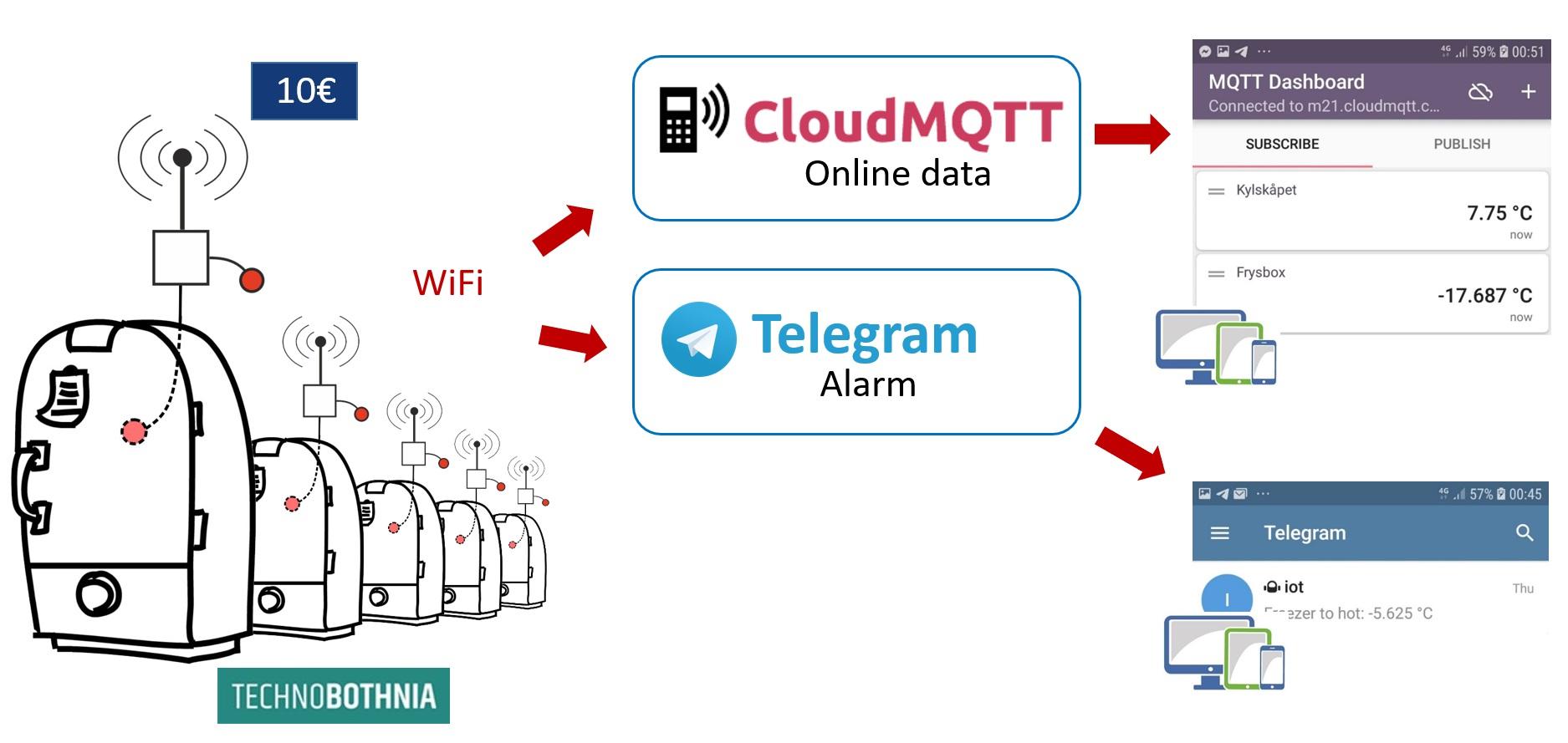Novia Cases
Soil temperature at Meteoria

Located at Meteoria (Söderfjärden), 10km south of Vasa. We have an array of 12 temperature sensors in the ground at 10 cm depth distance, from 10 cm until 120 cm.
We use low cost 1-wire sensors DS18B20 (2 €/pcs). A Raspberry Pi (40€) is connected with wire to the local Ethernet on site. A weather station and a pyranometer is also connected to the same Raspberry. Data is transferer to a datatbase at Novia UAS. Data has been saved to the database since autumn 2018. We also publish data on cloudMQTT , from here devices such as Phones and pads can subscribe on data in real-time.
The idea is to follow how ground frost is forming and melting. How deep the ground freezes from year to year. One can also study the slowness of heating and cooling of deeper layer of the ground. The first data presentation (we are working on a new layout summer 2019).
Update: data presentation is now online at iotdb.novia.fi
Ground temperature, Fladan

This device is planned to be place at a field at Fladan, close to the Airport of Vaasa. The sensors and measurements is the same principle as at Meteoria. We have an array of 12 temperature sensor in the ground at 10cm depth distance, from 10cm until 120cm.
This device is different than the first one. Here we do not have electricity or Internet. This device is powered by 3 AA-batteries, and we use LoraWAN to transfer data to our server at Novia. The 1-wire sensors is read by a Pycom LoPy4 microcontroller card. Thes Pycom have 4 types of radios, Wifi, BLE, Lora and Sigfox. We use the the Lora radio. Data is transfered to the Digita LoraWAN network . With a testing sampling rate of 5 minutes, we get a lifetime of about one month. When placed on the field we probably lower this to every half hour or every hour. Then the battery will last half a year or a year.
The Digita servers use RestApi to transfer the data to our system at Novia. We use a node.js webserver to store the data to our database and present it to the user. The presentation is not yet open to the public. In the summer 2019 it will be available.
Monitoring of refrigerators and freezers in Technobothnia

In Technobothia we have some 20 refrigerators and freezers. Most of them are full of samples for research. On average 1 or 2 breaks every year. In this case we use IoT to monitor and send messages if the temperature is out of limits.
We use the local Eduroam wifi-network. We use DS18B20 low cost (2€/pcs) sensors. We use Espressif ESP32 microcontroller card to do the measurements and send the data to CloudMQTT and alarms to Telegram. Both are free of charge. Telegram is similar to Watsapp. Whatsapp does not suport machines only human users.
The researchers can in real-time follow the temperature of their samples on their phone, pad or computer. By subscribing at the temperature of their refrigerator or freezer. They can also receive Telegram message if the temperature is outside limits. The message will be sent at the minute it happens. The ESP32 will continue to send messages every 30 minute as long as the temperature is outside the limit.
Temperature at Vasa beaches

This case is done in cooperation with Visit Vaasa. The prototype for this have been tested and during May or June of 2019 we will put them on the beaches in the Vaasa region. At least one will bee equipped with water level sensor (pressure).
We have two versions of this case one low cost and one higher. The higher we bought from Ellenex in Australia. It consist of a the PLD2-L submersible temperature and pressure sensor. It is battery powered and uses LoraWAN for data communication. We use the Digita LoraWAN network to transfer the data to our server. Our node.js web server receive the restAPI package of data and save it to our database. The web server will also publish the data online. Hopefully this will be realized and open to public in the beginning of the summer 2019.
Another low cost version of water and air temperature sensors will be developed. We plan to use the Wemos TTGO microcontroller. It has three radios, WiFi, BLE and Lora. Since most beaches don’t have WiFi we plan to use Lora. And we use the Digita Lora network to get the data to our servers.
We also plan to use a public MQTT broker. In this way who ever can subscribe the temperatures to their system, phone, pad or computer in real-time.
